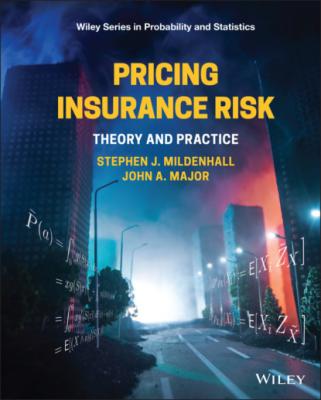Pricing Insurance Risk. Stephen J. Mildenhall
Чтение книги онлайн.
Читать онлайн книгу Pricing Insurance Risk - Stephen J. Mildenhall страница 19
 the Tame Case Study, Ins Co. writes two predictable units with no catastrophe exposure. We include it to demonstrate an idealized risk-pool: it represents the best case—from Ins Co.’s perspective. It could proxy a portfolio of personal and commercial auto liability.
the Tame Case Study, Ins Co. writes two predictable units with no catastrophe exposure. We include it to demonstrate an idealized risk-pool: it represents the best case—from Ins Co.’s perspective. It could proxy a portfolio of personal and commercial auto liability.
To simplify simulations and emphasize the underlying differences between the two units, the Case Study uses a straightforward stochastic model. The two units are independent and have gamma loss distributions with parameters shown in Table 2.4.
Table 2.4 Loss distribution assumptions for each Case Study. The Hu/SCS Case combines a Poisson frequency and lognormal severity
| Case | Unit | Distribution | Mean | CV | Frequency | µ | σ |
|---|---|---|---|---|---|---|---|
| Tame | A | Gamma | 50 | 0.10 | |||
| B | Gamma | 50 | 0.15 | ||||
| Cat/Non-Cat | Non-Cat | Gamma | 80 | 0.15 | |||
| Cat | Lognormal | 20 | 1.0 | 2.649 | 0.833 | ||
| Hu/SCS | Hu | Aggregate | 30 | 10.923 | 2 | −0.417 | 2.5 |
| SCS | Aggregate | 70 | 0.736 | 70 | 1.805 | 1.9 |
The Case includes a gross and net view. Net applies aggregate reinsurance to the more volatile unit B with an attachment probability 0.2 (¤ 56) and detachment probability 0.01 (¤ 69).
Loss statistics based on a Fast Fourier Transform (FFT) approximation (see Section 2.4.5) are shown in Table 2.5. The FFT approximation is essentially exact and it is used for all graphics and illustrations. Simulation can also be used. Table 4.6 shows various VaR, TVaR, and EPD levels. See the important comment in Section 2.4.5 regarding computational methods.
Table 2.5 Tame Case Study estimated mean, CV, skewness and kurtosis by line and in total, gross and net. Aggregate reinsurance applied to B with an attachment probability 0.2 (¤ 56) and detachment probability 0.01 (¤ 69)
| Gross | Net | |||||
|---|---|---|---|---|---|---|
| Statistic | A | B | Total | A | B | Total |
| Mean | 50.000 | 50.000 | 100.000 | 50.000 | 49.084 | 99.084 |
| CV | 0.100 | 0.150 | 0.090 | 0.100 | 0.123 | 0.079 |
| Skewness | 0.200 | 0.300 | 0.207 | 0.200 | −0.484 | −0.169 |
| Kurtosis | 0.060 | 0.135 | 0.070 | 0.060 | −0.474 | −0.157 |
Figure 2.2 shows the loss densities. The spike in the lower left plot is caused by the reinsured unit B hitting its limit, which produces a probability mass. Its magnitude is clear on the lower right, log scale, plot. The tail behavior of the two units is similar. Both have log concave gross densities. Figure 2.3 shows the bivariate plots. The outcomes are tightly clustered about their expected values.
2.4.3 Catastrophe and Non-Catastrophe Case Study
In the Cat/Non-Cat Case Study, Ins Co. has catastrophe and noncatastrophe exposures. The noncatastrophe unit proxies a small commercial lines portfolio. Balancing the relative benefits of units considered to be more stable against more volatile ones is a very common strategic problem for insurers and reinsurers. It arises in many different guises:
Should a US Midwestern company expand to the East coast (and pick up hurricane exposure)?
Should an auto insurer start writing homeowners?
What is the appropriate mix between property catastrophe and noncatastrophe exposed business for a reinsurer?
This Case uses a stochastic model similar to the Tame Case. The two units are independent and have gamma and lognormal distributions with parameters shown in Table 2.4.
The Case includes a gross and net view. Net applies aggregate reinsurance to the Cat unit with an attachment probability 0.1 (¤ 41) and detachment probability 0.005 (¤ 121).
Loss statistics based on an FFT approximation are shown in Table 2.6. The FFT approximation is good, though not as exact as the first case, and it is used for all graphics and illustrations. Simulation can also be used. Table 4.7 shows various VaR, TVaR, and EPD levels.